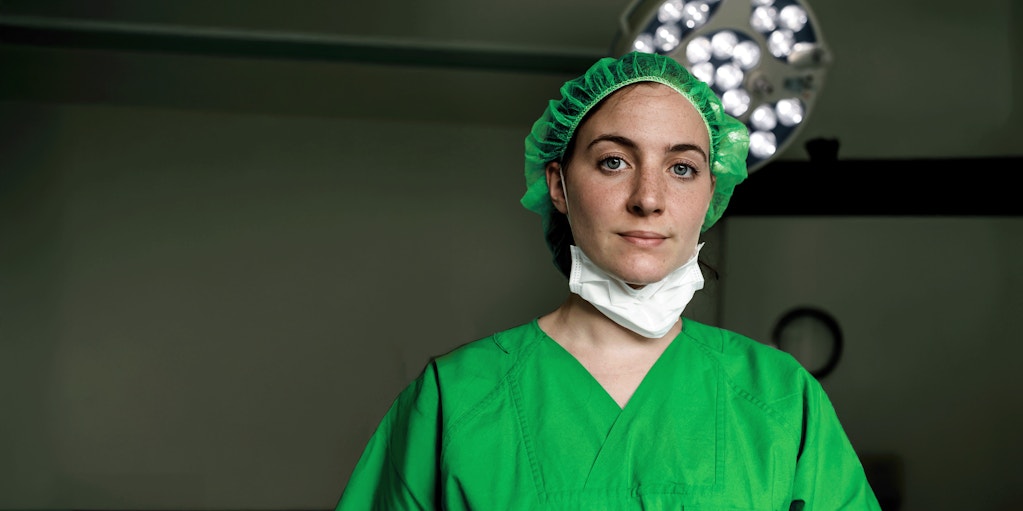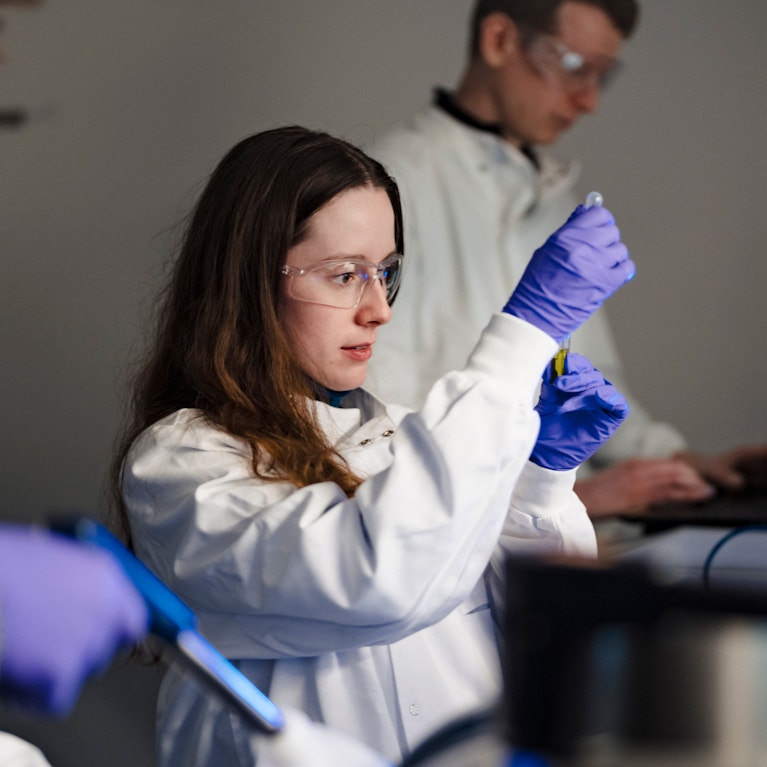
Imagine… Advanced digital surgery, anywhere, for everyone
Tags
From medieval barber-surgery to robotic precision, surgery continues to evolve through major technological advancements. Now, imagine if digital surgery could raise global surgical standards and deliver healthier lives through preventative interventions…
The clock struck 4pm on Friday, January 2030. Dr Marsell steadied herself for the final case of the week. A dull headache pulsed behind her eyes. It was the sixth operation of the day, and the 20th of the week – the pre-emptive removal of a pre-cancerous tumour. But despite the physical exhaustion, Dr Marsell carried a mental confidence. Where did this clinical resolve come from?
Dr. Marsell – and the anaesthesiologist, assistant, and nurses in the room – had access to the mindshare of the world’s best surgeons in the form of a digital platform. The platform made sense, in real-time, of the patient’s genetic and familial history, Dr. Marsell’s surgical technique, and the desired outcome to power the surgical robots that helped to perform the operation.
The result? Operations were faster and more precise. Moreover, the influx of data sparked daily improvements in procedures throughout the hospital. It started with helpful guardrails – avoid a blood vessel there, a nerve there. As the platform matured, it helped Dr. Marsell to make better clinical decisions based on her patients’ individual needs. Because of this, she trusted the sensor-embedded system as an extension of her fellow professionals.
From there to now
The vision of digital surgery above might have seemed fanciful a few years ago, but progress is fast underway. Earlier this year, researchers from Johns Hopkins University trained a surgical robot using imitation learning. The robot learned from demonstration videos, replicating movement to mirror the skill of human surgeons. This breakthrough eliminates the need to manually control or program robots for each specific movement during a medical procedure, moving closer to true autonomy. In future, robots could potentially perform complex surgeries independently, guided by learnings from global surgical data. Johns Hopkins researchers have now used a da Vinci robot, one of the earliest entrants to market, to tie a stitch in chicken and pig tissue without human intervention.
It’s not just robots driving this intelligence. Augmented reality goggles are aiding spine surgery through safe, accurate procedures. Outside of the operating room, AI is helping radiologists to detect cancer earlier, allowing physicians to biopsy cancerous tumours and develop treatment protocols sooner than ever thought possible. The US Food and Drug Administration receives hundreds of submissions for different AI platforms each year; over 100 AI submissions were approved by August 2024, and the volume will continue to grow in 2025.
Not all advancements are ground-breaking. Today, many companies choose small, iterative improvements such as adding sensors to devices to generate data in real-time. These sensors, teamed with imaging aids such as augmented reality, promise to provide guardrails for safer procedures. This piecemeal approach is important, enhancing the standard of care by making devices more accurate and effective, and boosting confidence in digital surgery. Ultimately, these guardrails will evolve into predictive, pre-emptive care – just like in Dr. Marsell’s future operating theatre.
Connecting data across the continuum of care, from emergency situations to health at home, is key to enhancing patient outcomes. These advancements promise an end to the geographic variability of healthcare quality. With digital surgery at its most optimal, surgeon variability is minimized through access to the distilled essence of the best surgical achievements in a central repository of excellence. This platform would provide surgeons with an ever-growing compendium of life-preserving, life-saving interventions, working with robotic surgical tools and advanced medical technologies to provide the best outcomes possible. Powered by global insights, the platform could suggest the best approach based on an individual patient’s history and genetic makeup. For example, analyzing a patient’s bone health, activity scores, and hydration levels could assess the likelihood of a future knee replacement, allowing for implant selection and placement specific to the patient (not just their condition).
While there’s a long road ahead, there are some perfectly achievable steps that medtech leaders can take now to bring together disparate data points in a constellation of knowledge, and win the trust of both surgeons and patients.
Feed the algorithm
Hundreds of surgical solutions lined the exhibition floor at the MedTech Conference in Toronto, showcasing the very best in tech-enabled surgery – advanced diagnostics, surgical navigation, visualization technologies, and surgical robotics. Speaking at the Conference, the head of digital and robotics for Stryker said that the algorithms are ready. They just need data to feed them.
The operating theatres of the past were characterized by ‘dumb’ forceps and scalpels. Today, sensors, robotics, and navigation systems aid complex procedures – and all produce data. When shared between surgical teams, this data has huge potential to significantly improve patient outcomes. But devices in the operating theatre are made by different manufacturers – think GE Healthcare, Medtronic, and Johnson & Johnson. To improve surgical procedures, these devices need an interoperable interface that turns surgeons’ decisions, movements, and patient responses into repeatable ones and zeros.
Once hospitals realize the extent to which data can drive a better standard of care, they may be more willing to collect and share it. Data insights will then need to be translated into the devices used during operations, and communicated to surgeons via robotic consoles, screens, or digital assistants. The mechanics of data collection isn’t the hard part. The complications come from philosophical questions around data consent and ownership, especially if hospitals look to monetize the data in some way. These sensitivities continue to discourage hospitals from turning sharp scalpels into smart ones.
Ultimately, patients will have to consent to their data feeding the algorithm, and many may feel uncomfortable doing so. However, our research into clinical trial participation found that 64 percent of people are willing to share their clinical data if it will improve treatments, and 65 percent will share data across clinical studies. This sentiment may well extend to the operating theatre. But even when data is willingly given, it will still need to be de-identified to protect individuals. This calls for encryption and tight cyber security.
To feed the algorithm with quality data, medtech leaders need to be part of the ecosystem of hospitals, payers, and surgeons, and communicate the immense value that these platforms generate – namely more effective surgery, better patient care, but also potential discounts from equipment manufacturers in exchange for data. Once insights are generated, medtech leaders play a key role in helping hospitals to find creative data-sharing solutions that make the platform more powerful over time. This involves building prototypes fed with publicly available data to show the potential value-add for the ecosystem.
Building trust with surgeons
Chances are you know someone who owns an electric car. But, 25 years ago, drivers were doubtful that electric cars would get them from A to B, let alone get them there safely. Today, however, more and more high-voltage vehicles are humming along the roads.
Trust comes from familiarity, and reassurance. In hyper-stressful medical environments, surgeons need systems to help them, not distract them or cause ‘analysis paralysis’. Surgeons need to be able to trust that the technology will improve surgical procedures and patient outcomes. And they need to know that devices, driven by global insights, will work in an accurate, precise, repeatable way.
Medtech leaders can build trust with surgeons by developing usable platforms that solve real unmet needs, augmenting surgeons’ decisions with valuable insights rather than telling them what to do. To avoid irritating surgeons with overbearing alerts (especially when repeated by nurses or assistants), systems could interact directly with surgeons, enabling them to action data as they see fit.
Personalization is key. If Dr. Marsell’s way of doing things is different to other surgeons in her speciality, it doesn’t mean it’s wrong. The best techniques start with experimentation – trying something new until it proves effective. Other surgeons adopt it, and it becomes the gold standard. The best outcomes will be achieved when surgeons’ decisions are enhanced by global practice and patient-specific information such as genetic data. And these better outcomes will create trust among surgeons.
The patients’ perspective
In 2018, genetic data from 23andMe, a consumer genetic testing company, was used to develop new drugs. The people who had shared their genetic data with 23andMe had no say, raising serious concerns about the commercialisation of medical data.
Media stories such as this, teamed with generally higher awareness about data privacy, mean that patients have never been more sensitive about protecting their health data. Add AI to the mix, and the question of trust intensifies. If patient data is used to feed algorithms, can patients be sure that their important personal information won’t be misused for commercial gain? And can they, the patient, derive a clear benefit from agreeing to share their data?
Say a patient with a cardiac condition has an orthopaedic procedure. Suddenly, after the op, they are bombarded with adverts for cardiac monitors. This would be annoying at best, and stress-inducing at worst. However, if the content is helpful and education – how to have a healthy diet, relieve hypertension, or reduce cholesterol – it would be welcomed.
It’s crucial for patients to understand that their data is only used while they are operated on, and, post-operation, de-identified outside of their electronic health record (EHR). The same securities ensure that EHRs are private to patients and their physicians. When patients know that their data will be used for a positive purpose, and not manipulated for commercial gain, they can see new solutions as beneficial to themselves and to others.
In a promising sign of patients’ willingness to share data, our recent survey of 2,000 US participants found that 64 percent said they would be willing to share their clinical data with researchers to aid the development of treatments or cures. When patients see the value in devices and platforms – namely improving procedures for them individually, but for other patients too – they will share data with greater confidence.
The stage is set…
While it might take another decade for advanced digital surgery to enter widespread use in operating theatres, the foundations are being laid today. Drawing on the scientific and technical capabilities at our Global Innovation and Technology Centre, we’re helping surgical robotics start-ups to miniaturize robotics, add intelligence to data streams, and use computer vision algorithms to augment vision systems. We’ve also worked with the American College of Emergency Physicians (ACEP) to develop a clinical registry that paves the way for future data platforms. The ACEP’s new digital platform absorbs and consolidates hundreds of complex data sets to deliver digestible reports on the quality of care. Empowering emergency physicians with actionable, data-driven insights transforms patient outcomes while supporting clinical innovation. In time, these innovations will hone the accuracy of surgeons’ movements, improve safety, and automate complex tasks such as dissection, resection, and anastomoses.
By engaging with the ecosystem to find mutually beneficial arrangements, medtech leaders can entice hospitals and patients to share data. At the same time, they can work directly with surgeons and patients to build trust through education, personalization, and useability. However, the most important action is to keep innovating.
Digital systems should augment, not replace, surgical teams. In the future, Dr. Marsell will still guide the procedure but will no longer operate based on her personal experience alone. She will access insights from an international consortium of surgeons and practitioners, and select the best technique for each patient – regardless of the week she’s had. For patients, faster procedures and fewer complications will mean less time spent in hospital and quicker recovery: better health outcomes for more people, everywhere.
Explore more










